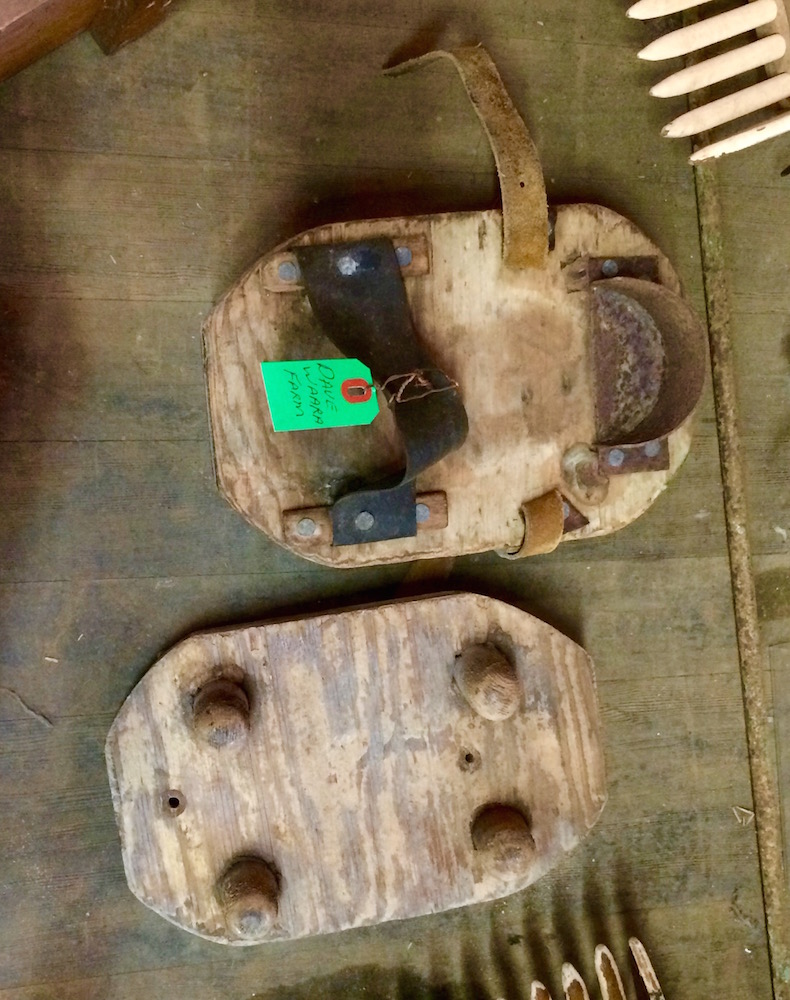The Furford Cranberry Picker/Pruner:
Ingenuity That Revolutionized an Industry

People who wander about as they travel, as opposed to those who stick to a rigid and formal itinerary, often amble through out-of-the-way places where they learn about things that had never even crossed their minds – like how cranberries are harvested.

How many of us have walked down the aisle of the grocery store and have seen those little packages of brilliant red cranberries that seemingly appear out of nowhere around Thanksgiving? Pretty much everyone – including you.
How many times have you stopped to wonder how those bright red berries made it to that end aisle display next to the pomegranates? Probably never…or maybe you did think about it, and you pictured folks in waders, knee-deep in floating cranberries.

Now, before you go patting yourself on the back if you did conjure up that scene in your head, these aren’t the cranberries you are envisioning. These little babies all wrapped up in their cellophane package were harvested entirely differently.

If you happen to find yourself on walkabout in Grayland, Washington, you might just well discover the Furford Cranberry Picker Museum and learn the secret.
Full of old signs, crates, sorters, labels, and other cranberry-related items, the Museum transports you into a world of which you heretofore were unaware – the world of dry cranberry harvesting.

The Furford Cranberry Picker / Pruner Museum
In 1932 Finnish cranberry growers built a building for use as a business and social meeting place. During the Second World War, the building was converted into a processing plant where cranberries could be dried for use in soldier rations that were being used overseas. This was a boom time for cranberry growers who had never experienced such a high demand.

After the War
After the WWII, the demand for cranberries slumped and Ocean Spray, a farming cooperative, took over the building and used it as a processing plant. In 1966, Mr. Julius Furford purchased the building and began using it a manufacturing location for his now-famous Furford Cranberry Picker/Pruner, which he had recently patented.
His business was very successful, and in 1986 he moved the manufacturing and repair work to a new, larger building he had built next door. The original building was subsequently converted into the Furford Picker Cranberry Museum.
The museum is run today by a number of locals who volunteer to help keep it running. They give tours of the museum, and because most of them have been raised and have worked for years in the cranberry farming business, the tour can be quite unique and personalized according to who you get as a tour guide.

One thing is for certain about your visit to this museum. You may arrive knowing nothing about cranberries, but you will leave with an education. The guides walk you through all stages of cranberry farming from planting, to growing, to harvesting, and finally sorting and selling the berries.
The Museum has several unusual items such as a “Dim Out Zone” sign from the Second World War that states that headlights could not be used up and down the coast. Why? Because headlights and lights through windows in homes could be seen by the Japanese submarines off-shore. A number of the volunteers at the Museum lived through WWII along the Cranberry Coast and can tell you stories of what they experienced.

WWII Memorabilia
Dry Harvesting Cranberries
The northern climes of the East and West coasts of North America are both well-suited to growing cranberries, as are the central northern areas of the continent. Cranberries grow well in areas that stay mild in summer, so places such as Wisconsin and Quebec are ideally suited for this type of farming.

Cranberry Bogs
Cranberries are an evergreen species of woody vine that are trimmed to resemble shrubs. They prefer well-watered, acidic soil that can drain easily. Historically, peat bogs have been used to grow cranberries. However, as it became clear that peat bogs were environmentally important areas, new cranberry beds began to be constructed in areas that were more environmentally friendly.
Cranberry Harvesting Methods
Cranberries can be harvested using two different methods: wet and dry. For those of you who were picturing cranberry farmers in waders amongst millions of floating cranberries, it is because you have seen pictures that have become part of the most commonly-touted images of cranberry farming – and with good reason. Most cranberries are harvested using the wet method in which fields that are normally dry are flooded briefly to make gathering the berries easier.

Cranberry bog shoes
The major drawback to wet-harvested cranberries is that they spoil quickly. This makes them a bad candidate for sale as fresh fruit. Wet-harvested berries typically are used in jellies, sauces, juices, and as sweetened dried fruit. If cranberries are to be sold fresh, whether in farmers’ markets or in grocery store produce aisles, they must be obtained using a dry harvesting method. Dry harvesting was traditionally much tougher than wet-harvesting – that is, until Julius Furford came along and revolutionized the industry.
Dry Harvesting – The Challenge of Automation
In the 1880’s a special hand scoop was designed for dry harvesting. It combed through the vines and pulled off the cranberries. The labor to harvest cranberries using this method was difficult and back-breaking.

After the harvest, farmers had to return once again to prune their vines with a special bladed rake – another manual and laborious task. Everything to do with dry harvesting cranberries was grueling and labor-intensive. Necessity being the mother of all inventions, a number of people tried to come up with a way to make the process easier.
After the harvest, farmers had to return once again to prune their vines with a special bladed rake – another manual and laborious task. Everything to do with dry harvesting cranberries was grueling and labor-intensive. Necessity being the mother of all inventions, a number of people tried to come up with a way to make the process easier.

One of the first automation attempts involved vacuuming the cranberries off of the vines. While the vacuum-style picker was an improvement of sorts over using the the older scoop technique, the vacuums were quite heavy. This made it difficult to maneuver them among the soft sandy-peat bogs without causing damage to either the berries or the vines. As with the hand scoop method of harvesting, the vacuum picking technique still required hand pruning of the vines following the berry harvest.

Invention of the Furford Picker/Pruner
Among the many “mom & pop” cranberry farmers on the Washington coast was a man by the name of Mr. Julius Furford. His favorite hobby was tinkering with machines of all kinds. Mr. Furford initially came up with a design for an automated cranberry picker that he named the “Western Picker.” It had tines that would comb the cranberry vines, and conveyor paddles would dislodge the berries, carry, and then deposit them into a burlap bag. The Western Picker automated the tasks of picking and bagging, but it still left the laborious, manual process of trimming the vines.

Further tinkering produced a revised version of the Western Picker that trimmed the vines while it picked; thus, solving the riddle of how to pick and prune at the same time. This new machine dramatically increased the efficiency of cranberry picking and the overall productivity of the farmers.
This incredibly clever invention was named the “Furford Picker/Pruner.” This now world-famous machine did for cranberry harvesting what the cotton gin did for cotton processing.

Still in use around the world today, the Furford Picker/Pruner is manufactured in the same building in Grayland, Washington located right in front of the Museum. The company only makes about 20 new machines every year as they rarely break and almost never require complete replacement. A small 5-horsepower engine powers the picker/pruner, and it can be quickly removed for repair or replacement.
Although it has been around since the middle of the last century, the simple, yet effective method that the Furford Picker/Pruner uses for dry harvesting cranberries has yet to be beaten. In 1990, Ocean Spray made an offer of $250,000 to any person who could develop a better machine to dry harvest cranberries. The prize has yet to be claimed.

Sorting the Berries
At the Furford Picker/Pruner Museum, you can also learn about how the growers transport and process the dry-harvested berries. The museum houses a number of items that show how this process is accomplished.
Getting the cranberries out of the bogs once harvested is challenging due to the soft sandy peat soil in which they grow. To this end, light rail lines run through the center of most of the fields. Special carts are run along these rails which transport the bags of cranberries and vines to processing buildings right on the bogs. You can drive through the cranberry fields just across the street from the museum and see these for yourself.

Special rail cart used for hauling bags of cranberries after pruning.
Once the cranberries are out of the field, there is still sorting to be done. The sorting process is much the same as it was in the early 1900’s, and the simplicity of how the machines work is what makes them so interesting. Although the methods may seem outdated, they work quite well for this particular form of agriculture. In a world where technology is king, these highly innovative methods for automating cranberry sorting and grading have also stood the test of time.

Cranberry Grader.
The bags of cranberries and clipped vines gathered from the bogs are poured into a hopper on a special sorting machine called a Hayden Cranberry Grader. As the cranberries fall from the hopper, a blower blows off the vines. The cranberries, being heavier than the vines fall and land on a series of angled boards which cause the berries to bounce, or not bounce. If the berries bounce at a certain angle they land on a grading table. A berry that bounces indicates that it is good enough to be sold fresh. Berries that fail to bounce fall down. This indicates that they are bruised, squished, or too small.

The good berries that land on the grading area roll down a long table that looks like large combs lying on their sides. As the cranberries roll through these combs, the different size spaces between the tines route berries of different sizes to one side of the table or the other. At the end of the table are two collecting bags into which the cranberries fall.

The cranberries are sorted for color at a later stage – usually by the buyer. The bigger and redder the berries, the more money they are worth. Dry-harvested cranberries that don’t make the cut for fresh produce are used in canned sauces and other processed products.
Cranberry Vine Propagation
The bits of vine that are blown off the grading machine are either discarded or are bundled into bales and used to plant new fields. In the past, planting was done entirely by hand. Today, the vines are scattered thinly by hand across freshly-prepared ground and are then pressed down into the soil by a machine that has round, dull discs. This causes the vines to stand upright in the soil. This process also ensures that the vines are planted in perfect rows. These rows will be repeatedly combed and groomed until they form long hedges that grow in a certain direction. This makes harvesting the berries with the Furford Picker/Pruner easier. It takes 3 to 5 years before new cranberry plants are ready for their first harvest.

Cranberry vines and berries

Bog Access for Vehicles




